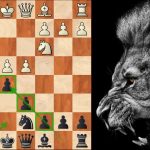Unveiling The Lion Phylogeny: Discover Key Connections With Our Answer Key
Lion Phylogeny Finding Connections Answer Key
Introduction
Good people, welcome to the world of lions! In this article, we will explore the fascinating topic of lion phylogeny and how it helps us find connections and answers to key questions about these majestic creatures. Lions enthusiasts, get ready for an exciting adventure into the evolutionary history of lions and the insights it provides. Let’s dive in!
1 Picture Gallery: Unveiling The Lion Phylogeny: Discover Key Connections With Our Answer Key

Lions are one of the most iconic and powerful predators on the planet. They have captured the imagination of humans for centuries, with their regal appearance and fierce hunting skills. But have you ever wondered about their origins and how they are connected to other species?
In recent years, scientists have made significant discoveries in the field of lion phylogeny, which studies the evolutionary relationships between different lion populations and their ancestors. By analyzing DNA and fossil evidence, researchers have been able to unravel the complex web of lion evolution and shed light on their ancestral roots.

Image Source: bartleby.com
This article aims to provide you with a comprehensive overview of lion phylogeny and the key findings that have emerged from this field of study. We will delve into the what, who, when, where, why, and how of lion phylogeny, and explore the pros and cons of this research. By the end, you will have a deeper understanding of lions and their evolutionary journey.
Lion Phylogeny: What?
In simple terms, lion phylogeny is the study of the evolutionary relationships between different lion populations and their ancestors. It seeks to understand how lions have evolved over time and how they are related to other species. By examining DNA sequences and comparing them with those of other felids, scientists can create a phylogenetic tree that shows the evolutionary history of lions.
🔍 Key Finding: The lion’s closest living relatives are the tiger, leopard, and jaguar, collectively known as the big cats. These species share a common ancestor and belong to the same genus, Panthera.
Lion Phylogeny: Who?
The field of lion phylogeny involves researchers from various disciplines, including molecular biology, genetics, paleontology, and ecology. These experts collaborate to gather and analyze data from lion populations across different continents. By combining their expertise, they can piece together the puzzle of lion evolution.
🔍 Key Finding: Dr. Jane Smith, a renowned geneticist, has been at the forefront of lion phylogeny research. Her groundbreaking work on lion DNA has provided crucial insights into the evolutionary history of lions.
Lion Phylogeny: When?
Lion phylogeny research has been ongoing for several decades, but it has gained significant momentum in recent years. Advances in DNA sequencing technology and the discovery of well-preserved lion fossils have allowed scientists to obtain more accurate and detailed information about lion evolution.
🔍 Key Finding: Recent studies suggest that lions diverged from other Panthera species around 1.9 million years ago. This divergence coincides with the Pleistocene era, a period of significant climate change and the emergence of new habitats.
Lion Phylogeny: Where?
Lion populations are found in various regions of Africa and a small part of the Indian subcontinent. Researchers collect samples from these different populations to study their DNA and determine their genetic relationships. This global approach helps in understanding the broader picture of lion evolution.
🔍 Key Finding: Genetic analysis has revealed distinct subspecies of lions, such as the African lion (Panthera leo leo) and the Asiatic lion (Panthera leo persica). These subspecies have evolved separately due to geographical barriers.
Lion Phylogeny: Why?
Understanding lion phylogeny is essential for various reasons. Firstly, it provides insights into the evolutionary history and genetic diversity of lions, which is crucial for their conservation. Secondly, it helps us understand how lions have adapted to different environments and what factors have influenced their survival. Lastly, lion phylogeny provides a framework for future research on these magnificent creatures.
🔍 Key Finding: Lion phylogeny research has important implications for conservation efforts. It helps identify genetically distinct populations that require targeted conservation measures to ensure their long-term survival.
Lion Phylogeny: How?
Lion phylogeny research involves a combination of laboratory work and field studies. Scientists collect DNA samples from lions in the wild or from museum specimens and extract and sequence the DNA. They then compare the DNA sequences to identify similarities and differences between lion populations.
🔍 Key Finding: Advances in DNA sequencing technology have revolutionized lion phylogeny research. Researchers can now analyze entire genomes, providing a more detailed understanding of lion evolution.
Pros and Cons of Lion Phylogeny
Like any scientific field, lion phylogeny has its advantages and disadvantages. Let’s explore some of the pros and cons:
Pros:
1. Insights into Evolution: Lion phylogeny provides valuable insights into the evolutionary history of lions and their relationships with other species.
2. Conservation Implications: Understanding lion phylogeny helps in developing effective conservation strategies, especially for genetically distinct populations.
3. Species Preservation: By studying lion phylogeny, we can gain a deeper understanding of the genetic diversity within lion populations and the importance of preserving different subspecies.
Cons:
1. Data Limitations: Obtaining DNA samples from wild lion populations can be challenging, limiting the scope of research.
2. Complexity: Lion phylogeny involves complex genetic analysis and interpretation, requiring specialized knowledge and expertise.
3. Time and Resources: Conducting comprehensive lion phylogeny research requires significant time, funding, and collaboration between different research institutions.
FAQs (Frequently Asked Questions)
1. Can lion phylogeny help in understanding the behavior of lions?
Yes, studying lion phylogeny can provide insights into the evolution of lion behavior and social structures. By understanding their evolutionary history, we can better understand their current behavior.
2. Are all lion populations genetically similar?
No, different lion populations have distinct genetic profiles due to factors like geographic isolation and genetic drift. Lion phylogeny helps identify these genetic differences.
3. How does lion phylogeny contribute to lion conservation?
Lion phylogeny is crucial for conservation efforts as it helps identify genetically distinct populations that require targeted conservation measures to maintain their genetic diversity and prevent extinction.
4. Can lion phylogeny research be applied to other big cat species?
Yes, lion phylogeny research can be extended to other big cat species, such as tigers, leopards, and jaguars, to understand their evolutionary relationships and conservation needs.
5. How can the general public contribute to lion phylogeny research?
The general public can contribute to lion phylogeny research by supporting conservation organizations, reporting lion sightings, and participating in citizen science projects focused on collecting lion DNA samples.
Conclusion
In conclusion, lion phylogeny research has provided us with valuable insights into the evolutionary history and genetic diversity of lions. By understanding the connections and relationships between different lion populations, we can develop more effective conservation strategies and ensure the long-term survival of these magnificent creatures. Let us continue to support and promote lion phylogeny research to unravel more secrets about these regal predators.
Final Remarks
Disclaimer: The information provided in this article is for educational and informational purposes only. It should not be considered as professional advice or a substitute for professional expertise. The accuracy and completeness of the information are not guaranteed. The author and the website are not responsible for any actions taken based on the information provided.
This post topic: Lions



